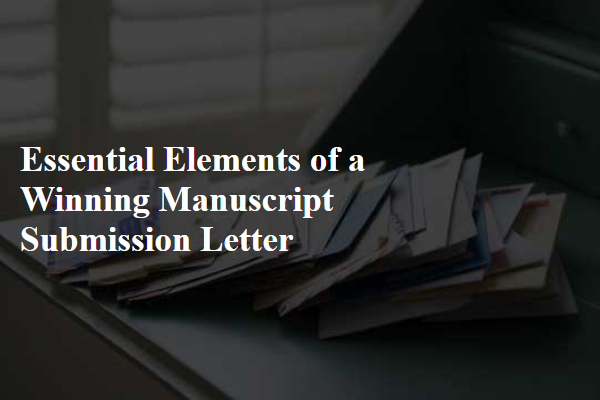
A winning manuscript submission letter clearly highlights the manuscript's unique qualities and target audience, demonstrating the author's understanding of market potential. It succinctly introduces the manuscript's genre, word count, and a compelling hook that captures the editor's interest. Including relevant author credentials and previous publishing experience strengthens credibility and increases the likelihood of consideration.
Compelling Subject Line
Crafting a winning manuscript submission letter is crucial for capturing the attention of literary agents and publishers. A well-structured letter highlights key aspects of your manuscript and your qualifications effectively.
- Concise Introduction - Clearly state the title, genre, and word count of your manuscript to provide immediate context.
- Compelling Synopsis - Summarize the plot or main argument in a captivating way that highlights the unique elements of your work.
- Author Credentials - Include relevant writing experience, awards, or publications to establish credibility and professionalism.
Incorporating these essential elements increases the likelihood of a positive response from industry professionals.
Personalized Salutation
What are the essential elements of a winning manuscript submission letter?
A well-crafted submission letter should include a concise introduction of the manuscript and its genre. It must also highlight the author's credentials and the unique aspects of the work.
How important is the personalization of a submission letter?
Personalizing the letter by addressing the specific agent or editor by name increases engagement. Researching the recipient's preferences ensures the letter aligns with their interests and submission guidelines.
What role does a synopsis play in the submission letter?
A brief, compelling synopsis provides a snapshot of the plot and main themes. It helps capture the editor's interest quickly and showcases the manuscript's potential.
Why should the letter be concise and professional?
Editors and agents receive numerous submissions daily, so clarity and brevity are crucial. A professional tone reflects the author's seriousness and respect for the recipient's time.
Should the author mention previous publications or accolades?
Including relevant publishing credits or awards can strengthen the author's credibility. This information demonstrates experience and enhances the manuscript's appeal.
Clear Manuscript Title
A winning manuscript submission letter clearly introduces the author and the title of the work, capturing the editor's attention immediately. It succinctly explains the genre and target audience, providing context for the manuscript's relevance.
The letter highlights the unique selling points of the manuscript without giving away the entire plot or content. It includes a brief author bio, establishing credibility and connection with the editor or publisher.
Purpose of Submission
A winning manuscript submission letter clearly introduces the author and the title of the work, capturing the editor's attention immediately. It succinctly highlights the genre and word count to provide essential context for the manuscript.
The letter includes a compelling synopsis that outlines the story's core conflict and unique selling points. It also demonstrates awareness of the target audience and explains why the manuscript fits the publisher's catalog.
Article's Unique Contribution
A winning manuscript submission letter must clearly identify the manuscript title and genre to capture the editor's attention immediately. It should also mention the word count and target audience to provide essential context.
Introduce yourself briefly, highlighting relevant credentials or publishing history to establish credibility. Summarize your manuscript succinctly, emphasizing its unique elements or compelling storyline. Finally, express appreciation for the editor's time and include your contact information.
Relevance to Journal Scope
A winning manuscript submission letter must clearly state the title, genre, and word count of the manuscript. It should include a concise author bio highlighting relevant credentials and publishing history. The letter must also provide a compelling hook or synopsis to capture the editor's interest immediately.
Summary of Key Findings
A winning manuscript submission letter captures the editor's interest while clearly presenting the work. It highlights the author's professionalism and the manuscript's relevance to the target publication.
- Clear Identification - Include the manuscript title, genre, and word count to provide essential information upfront.
- Compelling Synopsis - Summarize the core plot or main argument concisely to engage the editor immediately.
- Author Credentials - Share relevant publication history or background to establish credibility and suitability.
Statement of Originality
A winning manuscript submission letter captures the agent's or publisher's attention while clearly presenting key details about the book. It must be concise, professional, and tailored to the recipient's interests and requirements.
- Personalized Greeting - Address the agent or editor by name to demonstrate research and genuine interest.
- Compelling Introduction - Introduce the manuscript with a brief, engaging summary that highlights the book's unique angle or hook.
- Relevant Credentials - Include author qualifications or previous publications that establish credibility and marketability.
Conflict of Interest Disclosure
| Element | Description |
|---|---|
| Proper Formatting | Include sender's contact information, date, recipient's name and address, and a formal salutation. Use a clear, professional font and standard business letter format. |
| Concise Introduction | State the purpose of the letter clearly. Mention the title, genre, and word count of the manuscript submitted. |
| Personalization | Address the specific agent, editor, or publisher by name to show genuine interest and avoid generic letters. |
| Brief Manuscript Synopsis | Summarize the manuscript's plot, key themes, and unique elements without revealing the entire story or spoiling key twists. |
| Relevant Author Bio | Highlight professional credentials, writing achievements, or experiences that establish authority or enhance the manuscript's value. |
| Market and Audience Identification | Identify the target readership and include comparable titles or authors to position the manuscript within the market. |
| Polite Closing | Express appreciation for the recipient's time and consideration. Offer to provide a full manuscript or sample chapters upon request. |
| Proofreading and Accuracy | Ensure the letter is free of spelling, grammar, and punctuation errors to reflect professionalism and attention to detail. |
| Clear Call to Action | Specify the next step, such as requesting feedback, consideration for publication, or inviting contact for further discussion. |
Contact Information
A winning manuscript submission letter clearly introduces the author and the manuscript title while highlighting the genre and word count. It succinctly summarizes the plot or main argument, emphasizing the unique elements that make the work stand out. The letter also demonstrates the author's awareness of the target audience and expresses professionalism and gratitude towards the editor's consideration.



Comments